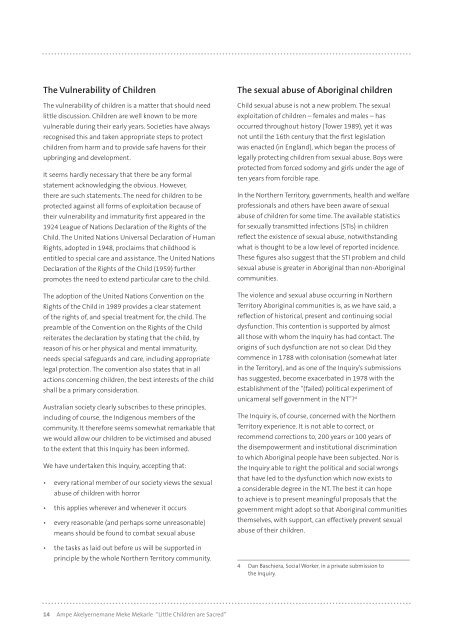bipacsa_final_report
bipacsa_final_report
bipacsa_final_report
You also want an ePaper? Increase the reach of your titles
YUMPU automatically turns print PDFs into web optimized ePapers that Google loves.
The Vulnerability of Children<br />
The vulnerability of children is a matter that should need<br />
little discussion. Children are well known to be more<br />
vulnerable during their early years. Societies have always<br />
recognised this and taken appropriate steps to protect<br />
children from harm and to provide safe havens for their<br />
upbringing and development.<br />
It seems hardly necessary that there be any formal<br />
statement acknowledging the obvious. However,<br />
there are such statements. The need for children to be<br />
protected against all forms of exploitation because of<br />
their vulnerability and immaturity first appeared in the<br />
1924 League of Nations Declaration of the Rights of the<br />
Child. The United Nations Universal Declaration of Human<br />
Rights, adopted in 1948, proclaims that childhood is<br />
entitled to special care and assistance. The United Nations<br />
Declaration of the Rights of the Child (1959) further<br />
promotes the need to extend particular care to the child.<br />
The adoption of the United Nations Convention on the<br />
Rights of the Child in 1989 provides a clear statement<br />
of the rights of, and special treatment for, the child. The<br />
preamble of the Convention on the Rights of the Child<br />
reiterates the declaration by stating that the child, by<br />
reason of his or her physical and mental immaturity,<br />
needs special safeguards and care, including appropriate<br />
legal protection. The convention also states that in all<br />
actions concerning children, the best interests of the child<br />
shall be a primary consideration.<br />
Australian society clearly subscribes to these principles,<br />
including of course, the Indigenous members of the<br />
community. It therefore seems somewhat remarkable that<br />
we would allow our children to be victimised and abused<br />
to the extent that this Inquiry has been informed.<br />
We have undertaken this Inquiry, accepting that:<br />
• every rational member of our society views the sexual<br />
abuse of children with horror<br />
• this applies wherever and whenever it occurs<br />
• every reasonable (and perhaps some unreasonable)<br />
means should be found to combat sexual abuse<br />
• the tasks as laid out before us will be supported in<br />
principle by the whole Northern Territory community.<br />
Ampe Akelyernemane Meke Mekarle “Little Children are Sacred”<br />
The sexual abuse of Aboriginal children<br />
Child sexual abuse is not a new problem. The sexual<br />
exploitation of children – females and males – has<br />
occurred throughout history (Tower 1989), yet it was<br />
not until the 16th century that the first legislation<br />
was enacted (in England), which began the process of<br />
legally protecting children from sexual abuse. Boys were<br />
protected from forced sodomy and girls under the age of<br />
ten years from forcible rape.<br />
In the Northern Territory, governments, health and welfare<br />
professionals and others have been aware of sexual<br />
abuse of children for some time. The available statistics<br />
for sexually transmitted infections (STIs) in children<br />
reflect the existence of sexual abuse, notwithstanding<br />
what is thought to be a low level of <strong>report</strong>ed incidence.<br />
These figures also suggest that the STI problem and child<br />
sexual abuse is greater in Aboriginal than non-Aboriginal<br />
communities.<br />
The violence and sexual abuse occurring in Northern<br />
Territory Aboriginal communities is, as we have said, a<br />
reflection of historical, present and continuing social<br />
dysfunction. This contention is supported by almost<br />
all those with whom the Inquiry has had contact. The<br />
origins of such dysfunction are not so clear. Did they<br />
commence in 1788 with colonisation (somewhat later<br />
in the Territory), and as one of the Inquiry’s submissions<br />
has suggested, become exacerbated in 1978 with the<br />
establishment of the “(failed) political experiment of<br />
unicameral self government in the NT”? 4<br />
The Inquiry is, of course, concerned with the Northern<br />
Territory experience. It is not able to correct, or<br />
recommend corrections to, 200 years or 100 years of<br />
the disempowerment and institutional discrimination<br />
to which Aboriginal people have been subjected. Nor is<br />
the Inquiry able to right the political and social wrongs<br />
that have led to the dysfunction which now exists to<br />
a considerable degree in the NT. The best it can hope<br />
to achieve is to present meaningful proposals that the<br />
government might adopt so that Aboriginal communities<br />
themselves, with support, can effectively prevent sexual<br />
abuse of their children.<br />
4 Dan Baschiera, Social Worker, in a private submission to<br />
the Inquiry.


